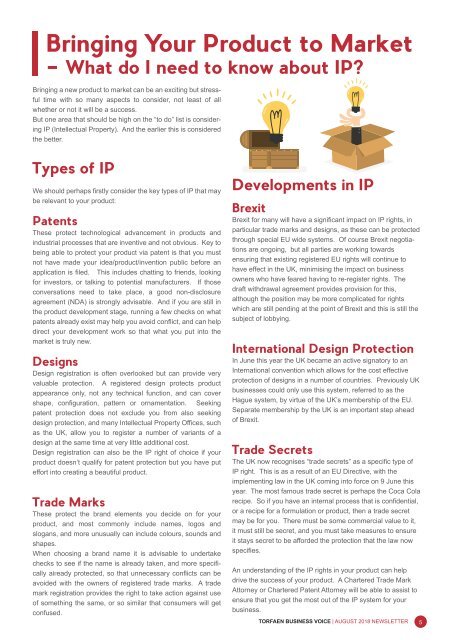TBV August 2018 - Full Edition
TBV August 2018 - Full Edition
TBV August 2018 - Full Edition
Create successful ePaper yourself
Turn your PDF publications into a flip-book with our unique Google optimized e-Paper software.
JANUARY<br />
Bringing Your Product to Market<br />
- What do I need to know about IP?<br />
Bringing a new product to market can be an exciting but stressful<br />
time with so many aspects to consider, not least of all<br />
whether or not it will be a success.<br />
But one area that should be high on the “to do” list is considering<br />
IP (Intellectual Property). And the earlier this is considered<br />
the better.<br />
Types of IP<br />
We should perhaps firstly consider the key types of IP that may<br />
be relevant to your product:<br />
Patents<br />
These protect technological advancement in products and<br />
industrial processes that are inventive and not obvious. Key to<br />
being able to protect your product via patent is that you must<br />
not have made your idea/product/invention public before an<br />
application is filed. This includes chatting to friends, looking<br />
for investors, or talking to potential manufacturers. If those<br />
conversations need to take place, a good non-disclosure<br />
agreement (NDA) is strongly advisable. And if you are still in<br />
the product development stage, running a few checks on what<br />
patents already exist may help you avoid conflict, and can help<br />
direct your development work so that what you put into the<br />
market is truly new.<br />
Designs<br />
Design registration is often overlooked but can provide very<br />
valuable protection. A registered design protects product<br />
appearance only, not any technical function, and can cover<br />
shape, configuration, pattern or ornamentation. Seeking<br />
patent protection does not exclude you from also seeking<br />
design protection, and many Intellectual Property Offices, such<br />
as the UK, allow you to register a number of variants of a<br />
design at the same time at very little additional cost.<br />
Design registration can also be the IP right of choice if your<br />
product doesn’t qualify for patent protection but you have put<br />
effort into creating a beautiful product.<br />
Trade Marks<br />
These protect the brand elements you decide on for your<br />
product, and most commonly include names, logos and<br />
slogans, and more unusually can include colours, sounds and<br />
shapes.<br />
When choosing a brand name it is advisable to undertake<br />
checks to see if the name is already taken, and more specifically<br />
already protected, so that unnecessary conflicts can be<br />
avoided with the owners of registered trade marks. A trade<br />
mark registration provides the right to take action against use<br />
of something the same, or so similar that consumers will get<br />
confused.<br />
Developments in IP<br />
Brexit<br />
Brexit for many will have a significant impact on IP rights, in<br />
particular trade marks and designs, as these can be protected<br />
through special EU wide systems. Of course Brexit negotiations<br />
are ongoing, but all parties are working towards<br />
ensuring that existing registered EU rights will continue to<br />
have effect in the UK, minimising the impact on business<br />
owners who have feared having to re-register rights. The<br />
draft withdrawal agreement provides provision for this,<br />
although the position may be more complicated for rights<br />
which are still pending at the point of Brexit and this is still the<br />
subject of lobbying.<br />
International Design Protection<br />
In June this year the UK became an active signatory to an<br />
International convention which allows for the cost effective<br />
protection of designs in a number of countries. Previously UK<br />
businesses could only use this system, referred to as the<br />
Hague system, by virtue of the UK’s membership of the EU.<br />
Separate membership by the UK is an important step ahead<br />
of Brexit.<br />
Trade Secrets<br />
The UK now recognises “trade secrets” as a specific type of<br />
IP right. This is as a result of an EU Directive, with the<br />
implementing law in the UK coming into force on 9 June this<br />
year. The most famous trade secret is perhaps the Coca Cola<br />
recipe. So if you have an internal process that is confidential,<br />
or a recipe for a formulation or product, then a trade secret<br />
may be for you. There must be some commercial value to it,<br />
it must still be secret, and you must take measures to ensure<br />
it stays secret to be afforded the protection that the law now<br />
specifies.<br />
An understanding of the IP rights in your product can help<br />
drive the success of your product. A Chartered Trade Mark<br />
Attorney or Chartered Patent Attorney will be able to assist to<br />
ensure that you get the most out of the IP system for your<br />
business.<br />
TORFAEN BUSINESS VOICE | AUGUST <strong>2018</strong> NEWSLETTER 5


















